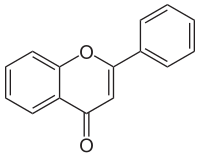
Photo from wikipedia
BACKGROUND Higher intakes of flavonoids provide health benefits, however, the importance of each flavonoid class and which population groups may receive the greatest protection from higher flavonoid intake warrants further… Click to show full abstract
BACKGROUND Higher intakes of flavonoids provide health benefits, however, the importance of each flavonoid class and which population groups may receive the greatest protection from higher flavonoid intake warrants further investigation. OBJECTIVE To explore the associations of flavonoid and flavonoid-rich wholefood intakes with all-cause mortality and the moderating effects of early mortality risk factors. DESIGN The study included 2349 participants of The Blue Mountains Eye Study, with a mean ± SD age at baseline of 64.7 ± 9.2 years. Flavonoid intake was calculated from baseline food frequency questionnaires using US Department of Agriculture food composition databases. Associations were examined using adjusted Cox proportional hazards models. RESULTS After 14 years of follow-up, 677 participants died. There was a flavonoid threshold effect with the greatest risk reduction seen between low and moderate intakes of total flavonoids, flavonoid classes and flavonoid-rich foods. Amongst the whole cohort, participants in the highest tertile of anthocyanidin intake had a significantly lower risk of all-cause mortality [multivariable adjusted HR (95%CI): 0.76 (0.61, 0.94)] when compared to those in the lowest tertile. Amongst participants with at least one early mortality risk factor (smoking, high alcohol consumption, no regular exercise or obesity), risk of all-cause mortality was lower in those in the highest intake tertile for total flavonoids [adjusted HR: 0.77 (0.59, 1.00)], flavan-3-ols [0.75 (0.58, 0.98)], anthocyanidins [0.70 (0.54, 0.92)], and proanthocyanidins [0.69 (0.52, 0.92)], compared to those in the lowest tertile. No similar associations were observed among those without any risk factors. Similarly, consumption of apples, tea and the individual flavonoid compounds, quercetin and epicatechin, were associated with a lower risk of all-cause mortality among participants with at least one risk factor, but not amongst other participants. CONCLUSION Moderate to high intakes of flavonoids and certain flavonoid subclasses may provide health benefits, particularly for individuals with at least one early mortality risk factor.
Journal Title: Clinical nutrition
Year Published: 2019
Link to full text (if available)
Share on Social Media: Sign Up to like & get
recommendations!